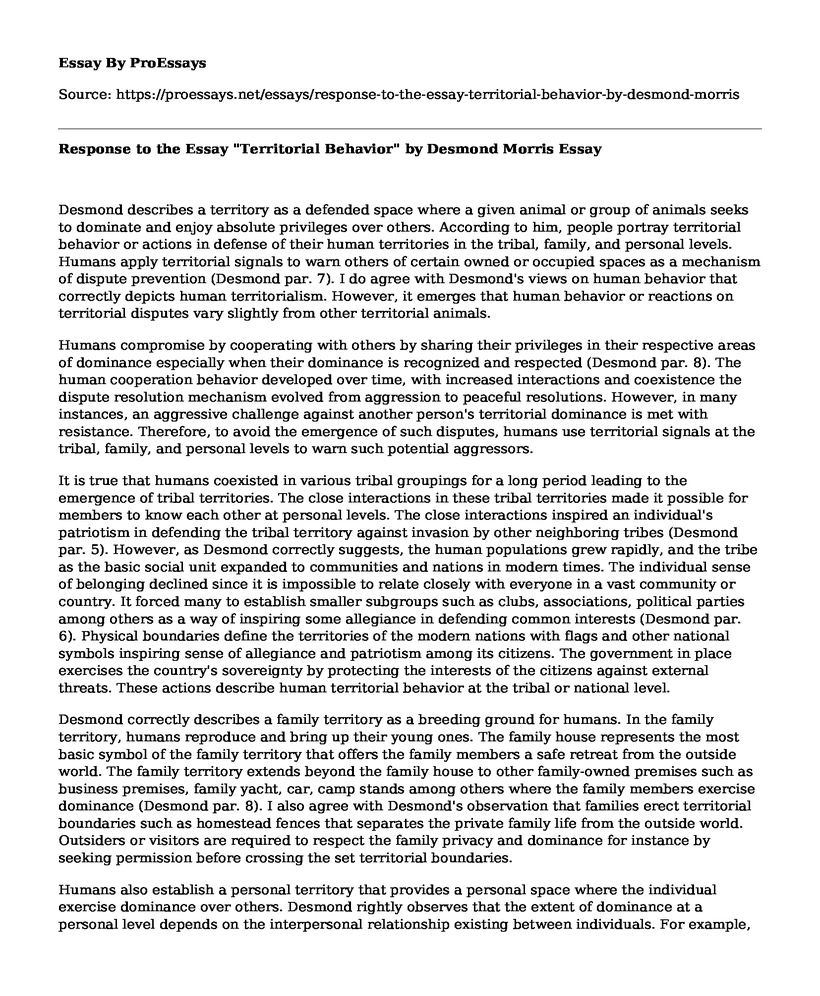Desmond describes a territory as a defended space where a given animal or group of animals seeks to dominate and enjoy absolute privileges over others. According to him, people portray territorial behavior or actions in defense of their human territories in the tribal, family, and personal levels. Humans apply territorial signals to warn others of certain owned or occupied spaces as a mechanism of dispute prevention (Desmond par. 7). I do agree with Desmond's views on human behavior that correctly depicts human territorialism. However, it emerges that human behavior or reactions on territorial disputes vary slightly from other territorial animals.
Humans compromise by cooperating with others by sharing their privileges in their respective areas of dominance especially when their dominance is recognized and respected (Desmond par. 8). The human cooperation behavior developed over time, with increased interactions and coexistence the dispute resolution mechanism evolved from aggression to peaceful resolutions. However, in many instances, an aggressive challenge against another person's territorial dominance is met with resistance. Therefore, to avoid the emergence of such disputes, humans use territorial signals at the tribal, family, and personal levels to warn such potential aggressors.
It is true that humans coexisted in various tribal groupings for a long period leading to the emergence of tribal territories. The close interactions in these tribal territories made it possible for members to know each other at personal levels. The close interactions inspired an individual's patriotism in defending the tribal territory against invasion by other neighboring tribes (Desmond par. 5). However, as Desmond correctly suggests, the human populations grew rapidly, and the tribe as the basic social unit expanded to communities and nations in modern times. The individual sense of belonging declined since it is impossible to relate closely with everyone in a vast community or country. It forced many to establish smaller subgroups such as clubs, associations, political parties among others as a way of inspiring some allegiance in defending common interests (Desmond par. 6). Physical boundaries define the territories of the modern nations with flags and other national symbols inspiring sense of allegiance and patriotism among its citizens. The government in place exercises the country's sovereignty by protecting the interests of the citizens against external threats. These actions describe human territorial behavior at the tribal or national level.
Desmond correctly describes a family territory as a breeding ground for humans. In the family territory, humans reproduce and bring up their young ones. The family house represents the most basic symbol of the family territory that offers the family members a safe retreat from the outside world. The family territory extends beyond the family house to other family-owned premises such as business premises, family yacht, car, camp stands among others where the family members exercise dominance (Desmond par. 8). I also agree with Desmond's observation that families erect territorial boundaries such as homestead fences that separates the private family life from the outside world. Outsiders or visitors are required to respect the family privacy and dominance for instance by seeking permission before crossing the set territorial boundaries.
Humans also establish a personal territory that provides a personal space where the individual exercise dominance over others. Desmond rightly observes that the extent of dominance at a personal level depends on the interpersonal relationship existing between individuals. For example, a junior worker will tend to keep a greater distance while interacting with his or her seniors but narrows the distance when interacting with a colleague and a friend in the same rank. Individuals often mark their territories with personal items to symbolize their control or ownership of the space (Desmond par. 11). For instance, in a workplace an individual place their photos and other personal items on a desk to claim temporary or permanent occupancy privileges.
Conclusion
Through these observations on human territorial behavior, I have learned that people establish and defend their territories at different levels. Peaceful coexistence depends on the ability of each human to recognize and respect other peoples created boundaries. However, it is also essential for humans to readily share their dominance through cooperation to avoid disputes over issues such as resource sharing. The human territorial behavior represents a vital means of preventing disputes by setting boundaries that signal to others on the individual's expectations.
Work cited
Morris, Desmond. "Territorial Behavior." SMC Homepage, retrieved from http://homepage.smc.edu/zehr_david/desmond_morris.htm
Cite this page
Response to the Essay "Territorial Behavior" by Desmond Morris. (2022, Aug 23). Retrieved from https://proessays.net/essays/response-to-the-essay-territorial-behavior-by-desmond-morris
If you are the original author of this essay and no longer wish to have it published on the ProEssays website, please click below to request its removal:
- The Ethical Issues of Gene Editing Technology: CRISPR/ Cas 9 System
- Communication in the Fire Service Paper Example
- Free Time: Unstoppable Transformation for Human Development - Essay Sample
- Essay Sample on Navigating Ethical Dilemmas in Global Business: Finding Common Ground
- Social Networking: Connecting the World, but at What Cost? - Essay Sample
- Biography Sample on Jane Addams: Champion of Peace, Philanthropy, Work Ethic
- Essay Example on August Wilson: American Playwright and Chronicler of African American Struggles







